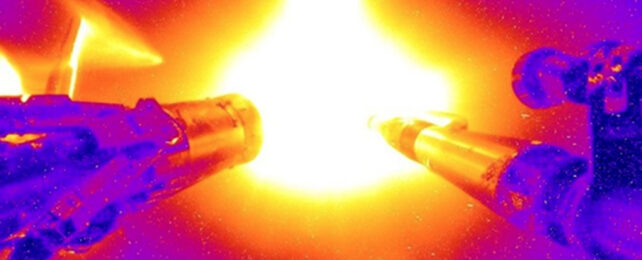For a second time since its landmark fusion event in 2022, the US National Ignition Facility (NIF) has squeezed enough energy out of a diamond capsule packed with hydrogen to keep the fusion reaction running.
Though still far short of producing a reliable, self-sustaining source of power for the community, the repeat achievement is bound to provide vital information on how to improve the technology.
Based at the Lawrence Livermore National Laboratory near San Francisco, the NIF's experimental fusion program uses some of the world's most powerful lasers to force hydrogen atoms into new configurations, leaving spare change in energy.
Getting a surplus in energy has long been a goal of the various innovators of fusion technology. For fusion to occur in magnetically confined whirlpools of plasma, the swirling maelstrom of small, charged particles needs to be toastier than the Sun's core before it can pay back any extra.
At the NIF, a tiny chamber no bigger than a fingernail filled with hydrogen isotopes soaks up the rays blasted from 192 powerful lasers to create the same kinds of conditions. Only then can the nuclear particles making up the isotopes rearrange to form helium (hopefully with some energy left over).
The first milestone – called ignition – occurs when the released energy is enough to sustain the fusion process.
After achieving the right conditions last December, the NIF has stoked its fusion engines in follow-up experiments to see if they can't improve output even further.
"In an experiment conducted on July 30, we repeated ignition at NIF," the facility announced in a recent Financial Times article.
"As is our standard practice, we plan on reporting those results at upcoming scientific conferences and in peer-reviewed publications."
Initial results suggest the total output was 3.5 megajoules – a fraction greater than the 3.15 megajoules released by the December ignition. With a touch over 2 megajoules of energy delivered by the lasers, the energy 'profit' seems impressive. And it is, if you want to use it to boil a few liters of water.
A fully-functional fusion plant based on NIF's technology would require lasers up to 100 times more powerful pulsing several times a second.
Scaling the technology up to light highways, heat showers, and run air conditioners for thousands of households will require many more ignition events like this, each revealing new ways to make the process more efficient and manageable.
Fusion power based on easily harvested hydrogen isotopes, if it can be achieved, would theoretically unlock virtually limitless amounts of energy unfettered by the radioactive waste problem of fission and the greenhouse-gas burden of carbon combustion.
Every step closer to that reality is worth taking a moment to celebrate.
